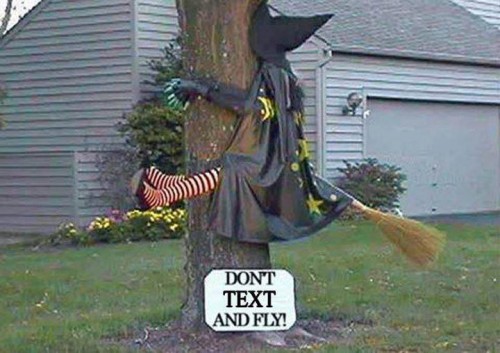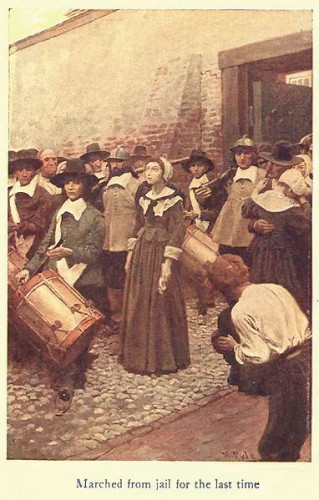No Ghoulies, No Ghosties, But a Witch? Yep. Part 2

McMurray Family, Burnell Family (Click for Family Tree)
If you haven’t completely overdosed on sugar and chocolate from Halloween, you may remember that we have our own accused witch in the family tree.
Hopefully not in the above kind of tree.
Let’s return to our own Mary (Bliss) Parsons…
Rumors about Mary continued to ‘fly’ in Northampton and Springfield despite her winning the slander case against Sarah (Lyman) Bridgman. Life, however, seemed to go on, with townspeople trading with each other despite the fear of evil in the neighborhood. This is one of the most curious things about a ‘witch’ in the community- despite the animosity of the accusations, the accused witch and her family were generally still able to do business in town, work for others, sell their crops or other goods, etc. The interdependence of a small frontier community always had to come first.
Eighteen years passed without significant incident, but bad feelings and nasty rumors continued concerning Mary and witchcraft. Joseph and Mary had more healthy children, prospered, as had most of their adult children as well. Mary’s mother, Margaret (Hullins) Bliss, along with Mary’s brothers, had also become successful after their move to Northampton following the death of Thomas Bliss, Mary’s father.
The bad luck of Sarah and James Bridgman continued, however. James had not moved up in the community economically, socially, or politically. Their married daughter, Mary (Bridgman) Bartlett died at about age 22 in August of 1674. The young mother had been healthy and then died suddenly, with no apparent illness. James Bridgman and his son-in-law Samuel Bartlett later testified that, “she came to her end by some unlawful and unnatural means.” They thought her death had been, “by means of some evil instrument.” The men appeared in the county court and requested inquiry into the matter. Mary (Bliss) Parsons knew the gossip, so decided to appear in court of her own accord, “desiring to clear herself of such an execrable crime.” The local magistrates did listen to Mary and evidence given, but deferred any decision until their next meeting, which was to be in November. Very little of the court records survive, but the second hearing was deferred until 5 January 1675.
In January more depositions were taken, and the court called Mary “to speak for herself.” Mary asserted her own innocence and continued, saying she was clear of the crime. The court records stated that she added, “the righteous God knew her innocency- with whom she had left her cause.” For a woman of that time, standing up in court to magistrates and the community was impressive, but Mary had the courage to do so. The young widower, Samuel Bartlett, was also in court this time, and provided the magistrates with testimonies, “many and various, some of them being demonstrations of witchcraft, and others sorely reflecting upon Mary Parsons as being guilty that way.”
![Winter in New York- similar to that in Massachusetts. William Rickarby Miller [No restrictions or Public domain], via Wikimedia Commons](http://heritageramblings.net/wp-content/uploads/2015/11/443px-Brooklyn_Museum_-_Winter_Scene_Pleasant_Valley_New_York_-_William_Rickarby_Miller_wikimedia_public-domain-370x500.jpg)
William Rickarby Miller [No restrictions or Public domain], via Wikimedia Commons
Interestingly, most likely at the same proceeding, there had been testimony that Mary’s 24 year old unmarried son John Parsons had a part in his mother’s witchcraft, or that he was a witch himself- the specifics are just not available. Few men were prosecuted as witches, and the court decided there was not, “any such weight whereby he should be prosecuted on suspicion of witchcraft.”
Mary was taken to Boston on 2 March 1675, stood before a Grand Jury, and was indicted on charges of witchcraft. Additionally, she was to be imprisoned in Boston for ten weeks while awaiting trial. Mary’s incarceration, being well-to-do, would not have been quite as miserable as for the lower classes in jail, but it surely was a horrible two and a half months after her comparative life of luxury. In those days, a family had to bring in or pay for meals, clothing, bedding,- even water for the prisoner. Mary’s family could easily afford her meals and warm clothes for a still-cold March and April in Boston, and probably paid for a larger cell that she could have to herself. Joseph owned warehouses in Boston so he had a place to stay and could conduct business, and visit his wife regularly. Still, being jailed and with a trial for witchcraft looming, it must have been a terrible and frightening experience.

The official charge was read at Mary’s trial on 13 May 1675: “Mary Parsons, the wife of Joseph Parsons, …being instigated by the Devil, hath entered into familiarity with the Devil, and committed several acts of witchcraft on the person or persons of one or more.” Mary was standing at the bar as she listened to the charge, raised her hand, and stated that she was not guilty. Although the court was filled with the elite of the colony including the governor, indicating Mary’s social rank and her husband’s connections, it was a jury of twelve men from the local area who decided her fate. Mary spoke on her own behalf, and part of the minimal records remaining state simply, on 13 May 1675: “The jury brought in their verdict. They found her not guilty. And so she was discharged.”
As had been the case before, although Mary (Bliss) Parsons had been legally cleared of witchcraft, the stigma of being ‘evil’ did not leave her. We will explore more about her life in upcoming posts, including more instances in which “hard thoughts and jealousies” affected her life.
Notes, Sources, and References:
- Witch Hunting in Seventeenth Century New England. A Documentary History 1638–1693, edited by David D. Hall, 2nd Edition, Duke University Press Books, 2005.
- “The Early Parsons Families of the Connecticut River Valley” by Gerald James Parsons. Part 1: Vol. 148, pp. 215- 238; Part 2: p335-360; Vol. 149:Part 3- pp53-72. The New England Historical and Genealogical Register. Boston, MA: New England Historic Genealogical Society, 1847-. (Online database: AmericanAncestors.org, New England Historic Genealogical Society, 2001-2013.)
- A Place Called Paradise. Culture and Community in Northampton, Massachusetts 1654-2004. Edited by Kerry W. Buckley, Historic Northampton Museum & Education Center/ University of Massachusetts Press. Chapter 3 is “Hard Thoughts and Jealousies” by John Putnam Demos, from his excellent, very comprehensive book Entertaining Satan: Witchcraft and the Culture of Early New England, New York, 1982.
- The History of Northampton, Massachusetts from its settlement in 1654,
by Trumbull, James Russell, (1825-1899); Pomeroy, Seth, (1706-1777), 1898. (Seth Pomeroy is a very distant cousin too.) Available on Internet Archive- https://archive.org/stream/historyofnortham00trum#page/n11/mode/2up
- Cornet Joseph Parsons one of the founders of Springfield and Northampton, Massachusetts, by Henry M. Burt, Garden City, 1898. –https://archive.org/stream/cornetjosephpar00parsgoog#page/n10/mode/2up
- Parsons Family. Descendants of Cornet Joseph Parsons Springfield 1636- Northampton 1655, by Henry Parsons, New Haven, 1912.
- Genealogy of the Bliss family in America, from about the year 1550-1880, by Bliss, John Homer, b. 1832, 1881. https://archive.org/stream/genealogyofbliss00blis#page/n3/mode/2up
Please contact us if you would like higher resolution images. Click to enlarge images.
We would love to read your thoughts and comments about this post (see form below), and thank you for your time! All comments are moderated, however, due to the high intelligence and persistence of spammers/hackers who really should be putting their smarts to use for the public good instead of spamming our little blog.